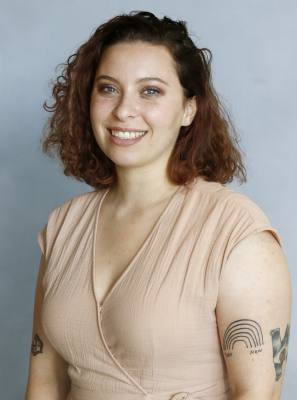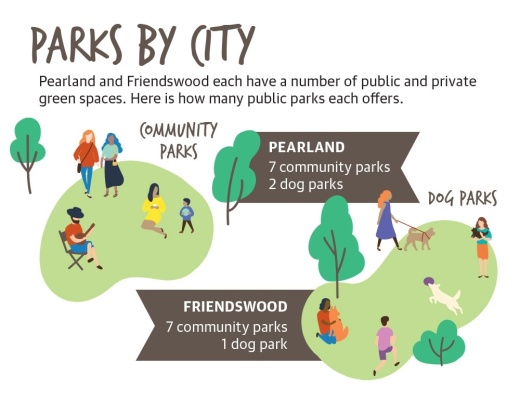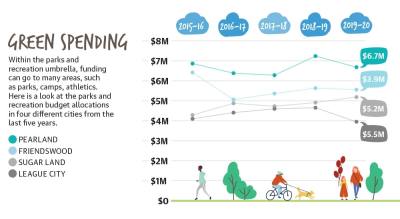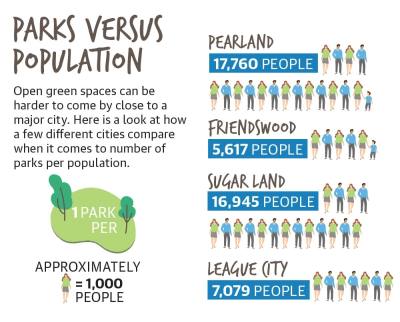City Council Member Adrian Hernandez said his involvement with the parks board and position as executive director of Keep Pearland Beautiful may make him feel more connected to the parks system, where he sees people reach out to the city for events the parks lack the infrastructure to handle.
Keep Pearland Beautiful is a nonprofit organization focused on empowering Pearland residents to take responsibility for their environment, according to its website.
“These are opportunities to bring arts and culture to the city we’re missing out on, and all of that has to do not just with park development, but economic development, quality of life and more,” Hernandez said.
During the last three fiscal years, Pearland allocated around 8% of the budget to its Parks and Recreation department. Though the percentage has remained consistent, this year’s department budget is around $500,000 lower than the previous year. This year the Friendswood Parks and Recreation Department was allocated 5% of the total budget, less than the 8% it received in fiscal years 2017-18 and 2018-19.
Pearland is home to seven community parks, 10 neighborhood parks and two dog parks. Friendswood has seven community parks and a dog park.
“Pearland is a city that offers so many opportunities for outdoor activities and maybe not everyone knows how much we have,” Hernandez said.
Local measures
Phase 1 of Independence Park renovations was a major parks project that was completed in Pearland last year. These renovations included a new amphitheater, a tunnel with a mural and a playground.The Phase 1 renovation was a part of the 2017 capital improvement plan created by the city and cost approximately $4 million.
Phase 2 for Independence Park had been removed from the 2019 bond, Hernandez said, effectively removing it from the capital improvement plan. The parks proposition, which passed in May 2019, was for $2.5 million and used to extend the lifespan of city recreational offerings, according to the city website.
“At the time, the park was still under construction due to weather delays, and some council members felt that since we hadn’t set foot on Phase 1, why did we need to think about Phase 2?” Hernandez said. “Now that the first round of construction is done, it is blatantly obvious the park is incomplete.”
Hernandez said he hopes to bring Phase 2 back as a priority on the capital improvement plan at upcoming council meetings.
A recently completed parks project in Friendswood is the Friendswood PetSafe Dog Park, the city’s first off-leash dog park. Located in Old City Park, the dog park was the result of a local high school student and Life Scout’s Eagle Scout project and was largely funded through a grant from the PetSafe Bark for Your Park initiative.
Other parks projects were up for approval in a bond that failed to pass during the November bond election. The $8 million bond would have funded upgrades to Stevenson and Old City parks, improvements to the Clear Creek Green Belt design and maintenance for Renwick Park and the city pool .
“With anything that did not pass in November, council members can try to make them happen in an annual budget as opposed to a bond,” Friendswood Communication Specialist Jeff Newpher said. “Each project will be individually considered by council at future meetings.”
None of these projects has been discussed at Friendswood City Council meetings in the months since the last election, Newpher said.
An organization working to make park projects happen is the Forever Parks Foundation of Pearland.
Kelly Moody, president of the Forever Parks Foundation, said parks bring value not only as an attraction for people to move to a city, but also as a place where people can gather and make connections.
“They provide an opportunity to try new things, experience nature and competitive sports, festivals, concerts,” Moody said. “It’s for physical, emotional, psychological well-being.”
The Forever Parks Foundation acts as an advocate for the Pearland parks and recreation department. It provides the city with a secondary income for park project funding, Moody said.
The organization, which was formed in 2015, determines several large projects each year that have been identified as goals for the city and align with the parks and trails master plan.
The three main projects for 2020 are a financial assistance program for camps and other activities, an educational pond at the nature center and an all-inclusive playground at the sports complex for children of all abilities, Moody said.
“Council members have to work in the constraints of the budget, even though parks are a priority,” Moody said.
While parks and recreational opportunities remain a priority for the city overall, Newpher said when it comes down to the final decision, each council member has projects they feel most strongly about.
In Friendswood, the budget is scrutinized number by number before being made into several decision packages that are presented to the City Council to decide between, Newpher said.
“Parks and recreation is in there with everyone else, but it comes down to the council members’ individual priorities,” Newpher said. “Different people will have different projects they prioritize.”
City growth
As Pearland and Friendswood continue to grow in population, construction of new developments and neighborhoods in the area will remain an influence on the city green spaces.Newpher said green space is under consideration at all levels of discussion about new development projects.
“Planning and Zoning [Commission] does public meetings to hear what the community wants or needs out of any given project, and then they make a recommendation to the council with those considerations in mind,” Newpher said.
In Pearland, Hernandez said the use of green space in new developments is a part of the conversation even if it is not a requirement.
“All developers that come to the city support parks and trails in one way or another, through payments that are part of the planning process,” Hernandez said.
Russel Bynum, general manager of Hillwood Communities’ Houston branch, said in some cases, cities require a certain amount of open space per acreage. Pearland and Friendswood do not require an amount of acreage, but developers contribute to the green space maintenance in other ways.
Hillwood built the Pomona master-planned community in Manvel. The community will cover around 1,000 acres and contain approximately 2,100 homes once it reaches build-out. Bynum said 300 acres will be dedicated to open green space.
“Manvel didn’t require it, but as developers, parks and open spaces are something we take pride in planning and developing,“ Bynum said.
Within the 300 acres, the green space will vary between detention lakes, parks, a recreation center and trails, and it will provide a place to gather and interact with nature, Bynum said.
Bynum said one pillar of his company’s development practices is creating connection among the residents, and having these green spaces allows residents to connect with one another by coming together.
Moody agreed and said parks and trails provide a place for people to enjoy nature and build relationships as well as an opportunity to try new things.
“Parks just do so much to bring communities together,” Moody said.








